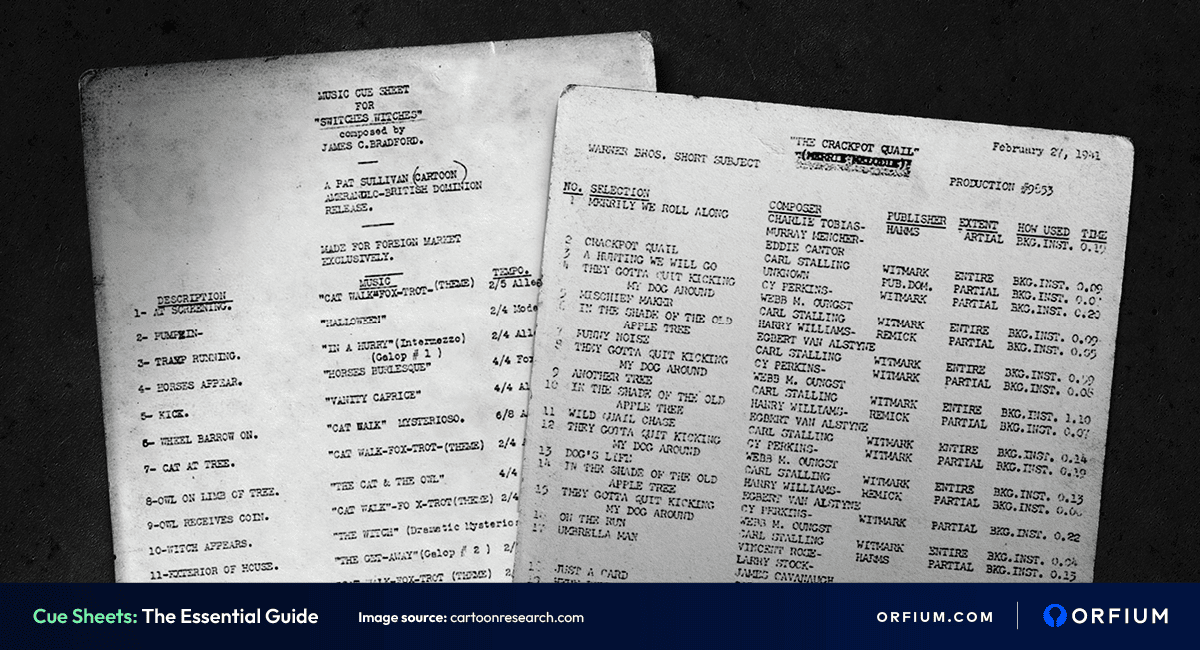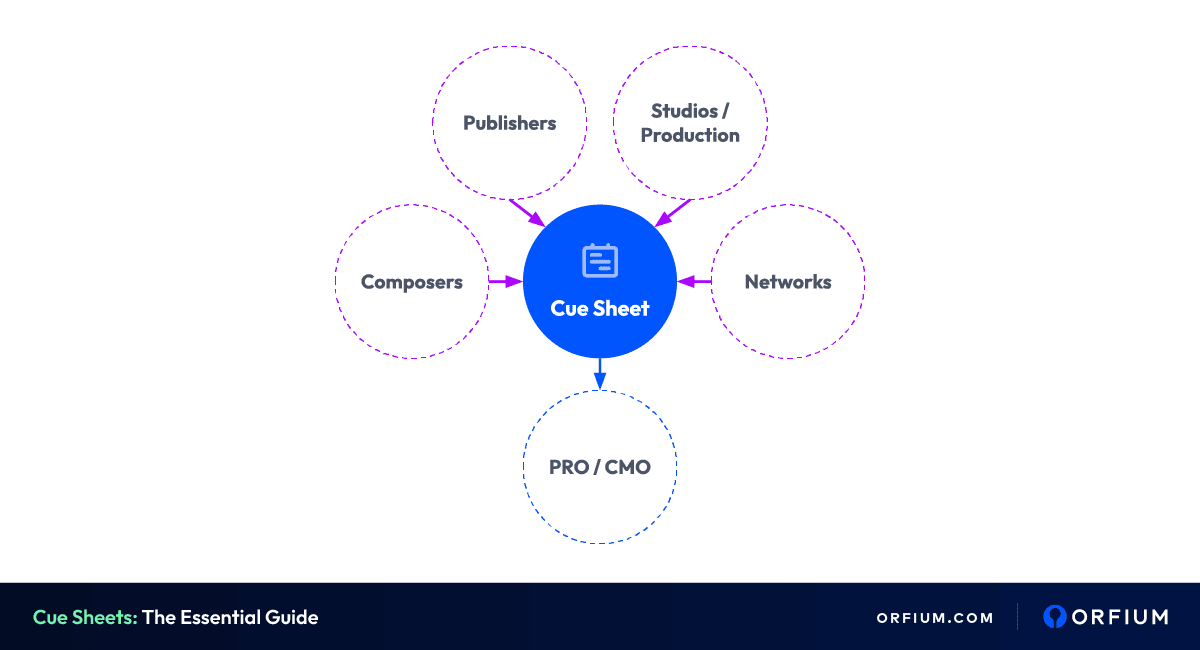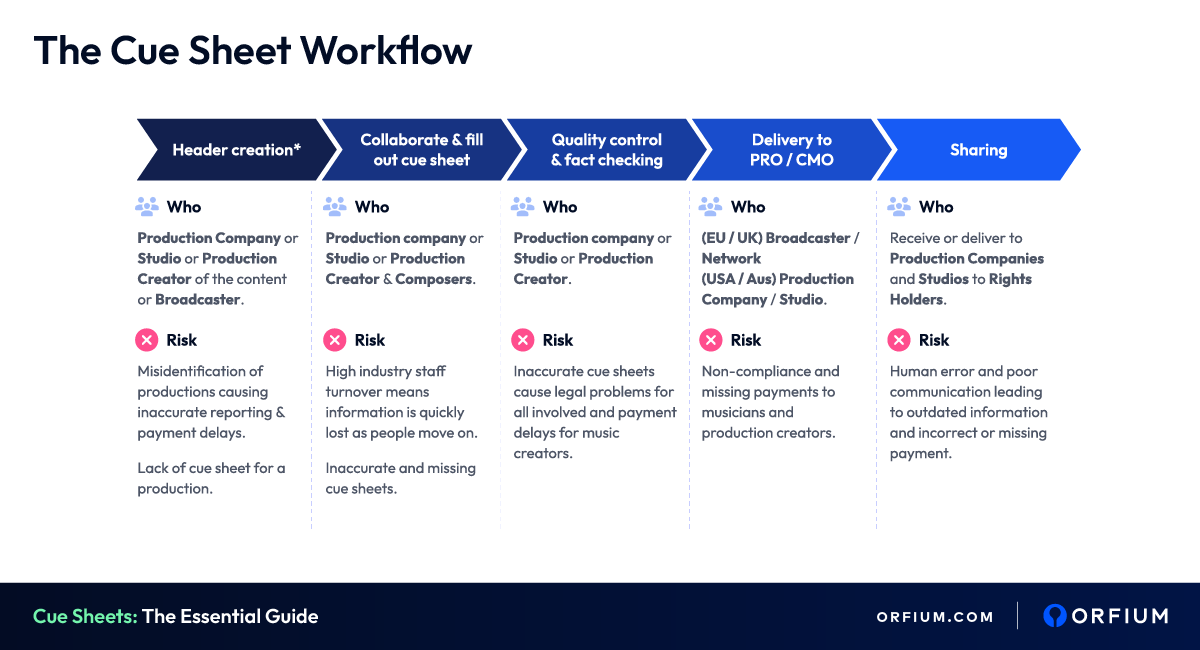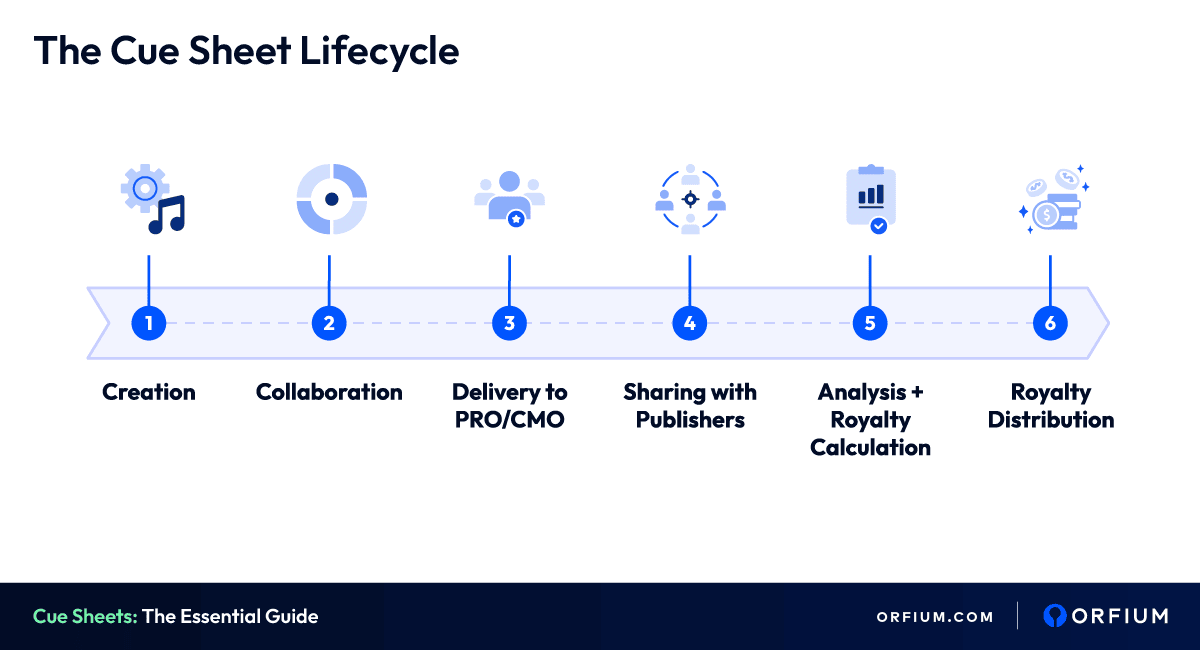
In the world of music and entertainment, cue sheets play a vital role in ensuring that music creators are properly compensated for their work when their music is used in any audiovisual production. Whether you’re a composer, musician, publisher, broadcaster or part of a production team, understanding cue sheets is essential for navigating the complexities of music licensing and royalty distribution. This essentials guide will provide you with a solid foundation in cue sheet essentials, empowering you to manage your cue sheets effectively to avoid financial losses and possible legal compliance issues.
What is a cue sheet?
A cue sheet is a detailed document that lists all the music and how it was used in a production, such as a film, TV show, video game, podcast, or commercial. Think of it as an ingredient list for all the musical elements that make up the soundtrack. Historically, cue sheets were paper-based, but today, digital spreadsheets and cloud-based platforms are used to improve efficiency and accuracy.

Why do you need a cue sheet?
Cue sheets serve several crucial purposes:
- Fair Compensation: Cue sheets ensure that composers, publishers, and musicians receive the royalties they are entitled to when their music is used.
- Legal Compliance: Cue sheets help studios and production companies use music legally and ethically, avoiding potential lawsuits and fines.
- Accurate Tracking: PROs* rely on cue sheets to track music usage and distribute royalties to the correct rights holders.
*Performing Rights Organizations (PROs): Organizations like ASCAP, BMI, and SESAC that collect and distribute royalties to their members (composers, publishers, and songwriters).

Who is responsible for cue sheets?
Creating and managing cue sheets is a collaborative effort involving several key players:
Composers & Publishers:
Why do Composers & Publishers need to complete cue sheets?
- Cue sheets ensure you receive proper credit for your work.
- They guarantee accurate royalty payments for the use of your music.
- Cue sheets help you track where and how your music is being used.
What happens if you don’t complete your cue sheets correctly?
- You may not get paid for your music correctly or at all.
- There may be difficulty in tracking your music’s usage and collecting royalties.
Studios and Production Teams:
Why do Studios & Production Teams need to complete cue sheets?
- To maintain legal compliance and avoid copyright infringement.
- To demonstrate ethical practices and respect for music creators.
- To ensure smooth production workflows and timely payments.
- To build strong relationships with composers and rights owners.
What happens if you don’t submit cue sheets correctly?
- You may face legal issues, including lawsuits and fines.
- There’s likely to be reputational damage and loss of trust in your organization.
- You may suffer disruptions & potential delays (which cost you money) to production schedules and distribution.
- You’ll likely cause relationships to strain with composers, rights owners and CMO/PROs.
- You’ll run the risk of not getting paid.
Networks and Broadcasters:
Why do Networks & Broadcasters need to complete cue sheets?
- To fulfill licensing obligations and avoid legal challenges.
- To maintain accurate records of music usage for reporting and auditing.
- To ensure compliance with international broadcasting regulations.
- To enable market share calculations.
- To support fair compensation for music creators.
What happens if you don’t complete and submit cue sheets correctly?
- You’ll risk causing program interruptions and content takedowns.
- You may face financial penalties and legal disputes.
- Your reputation and audience trust may be damaged.
- You’ll face difficulties in securing future music licenses.

What information do you need to put in a cue sheet?
A cue sheet is a comprehensive record of every musical element incorporated into an audio visual production. To ensure clarity and accuracy, a cue sheet is divided into distinct sections:
Production Details
This section sets the stage by clearly identifying the project. It includes essential information such as the title of the production (film, TV episode, etc.), the production duration, the episode number (if applicable), the production company responsible, the release date and any specific production identifiers (contract number or production number for example). This information helps connect the cue sheet to the correct production, ensuring that the music usage is properly tracked and attributed.
Music Details
This is the heart of the cue sheet, where each piece of music used is meticulously documented. It includes a range of crucial details:
- Title: The title of the musical work.
- Composer(s): The names of those who created the music.
- Publisher(s): The entities responsible for managing the rights to the music.
- Performer(s): The names of the individuals or groups who performed the music (if applicable).
- Usage Type: A description of how the music is used in the production, such as background music, theme music, or feature music. This information is vital for calculating royalties, as different usage types have different royalty rates.
- Unique Cue Number: A unique identifier assigned to each piece of music to facilitate tracking and organization.
- Exact Start and Stop Times: Precise timecodes indicating when each piece of music begins and ends within the production.
Other Cue Sheet Information
In addition to the core elements, a cue sheet may include supplementary information to provide a more complete picture of the music usage:
- Synchronization License Details: Information about the license that grants permission to use the music in synchronization with the visual elements of the production.
- Description of Music Usage: A more detailed narrative description of how the music is used to enhance the scene or convey a particular mood.
- Recording Information: Details about the specific recording used, such as the record label, recording date, and any relevant catalog numbers.
- Specific Codes or Details for PROs: Any specific codes or information required by the relevant Performing Rights Organizations.
By carefully (with attention to details such as spacing and capitalization!) capturing all these details, a cue sheet becomes a comprehensive and reliable record of music usage, ensuring that all rights holders are properly identified and compensated.
The Cue Sheet Lifecycle

Understanding the journey of a cue sheet gives valuable insight into its importance:
- Initial Cue Sheet Creation: Begins during pre-production, where the music supervisor or coordinator logs each piece of music used.
- Collaboration: Editors, sound mixers, and composers contribute to the cue sheet, adding precise timings and usage details.
- Optimization: Cue sheet software streamlines the process, reducing errors and kicking off collaboration on data gathering and cross-checking.
- Review: The cue sheet undergoes a thorough review for accuracy and completeness.
- Delivery to PROs: The completed cue sheet is sent to the relevant PROs (e.g., ASCAP, BMI, SESAC).
- Sharing: Copies are shared with publishers, broadcasters, and other relevant parties.
- Analysis: PROs analyze the data and match music usage to their databases.
- Calculating Royalties: Royalties are calculated based on the verified information in the cue sheet.
- Royalty Delivery: PROs distribute the royalties to the appropriate music creators.
For more insights, watch and hear from seasoned industry experts Sean Novak from NBCUniversal and Mark Vermaat from Orfium: